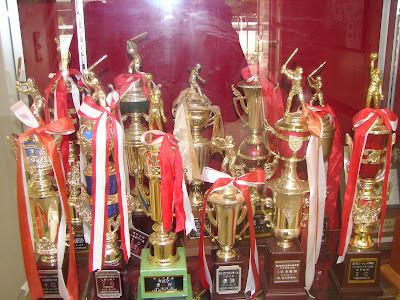
We leave our shoes at the genkan, and put on our slippers for walking around the school.

A student's ikebana is displayed at Motoyama Elementary School.

Student artwork and kanji, from an elementary school classroom.

Unicycles and stilts for playground use at Motoyama Elementary School.

Student artwork displayed at Sanyo Onoda City Asa Junior High School.

Jr. High and High School students almost all ride bicycles to school, so schools have big bicycle parking sheds.

Robots with light sensors, built by students at Yamaguchi Prefectural Onoda Technical High School.

This robot, also built by a student, moved the basketballs from one side of a complicated obstacled course to the other.
Over the past several days, our group visited 3 different Japanese schools here in Sanyo Onoda. We spent a whole day at each school, arriving with the students and staying until 4:30 so that we could see the after-school club activities. All the schools we visited had after-school clubs, and almost all the kids participated in the club activities, so the schools were still full of kids and teachers when we left at 4:30.
The first visit was to an elementary school. Like CMDS, it had a kindergarten through 6th grade. We arrived early so that we could greet the children as they arrived at school. It was a community school, and all the kids we saw were either walking or riding bicycles to school. They greeted us with "good morning" in English as they passed; I think they had practiced saying it, in preparation for our visit. They played on a big playground before school, and the school had unicycles for them to use, which some of them were riding around on the playground. Then we went inside the building, took our shoes off in the genkan, and put on our slippers for walking around inside the school.
Throughout that day we visited classrooms, and saw students learning reading, writing, math, art, and music. Girls were also taught ikebana, which is the Japanese art of flower arranging. There were many beautiful ikebana arrangements displayed around the school. One class that I visited was learning English by singing some of the same songs we know at our school -- they sang "There was a farmer had a dog, and Bingo was his name-o." Another class sang "head, shoulders, knees and toes," while doing the movements. I think songs are a great way to learn words in a foreign language, don't you? Especially songs with movements. At the end of the school day, we had a great surprise. We were invited to the auditorium, and the children performed traditional Japanese taiko drumming for us. It was great! Afterward, they invited our group of American teachers up on stage, and with the help of the kids to set the rhythm, we got a chance to try it too.
The next day we visited a lower secondary school (which would be called a Jr. High school here) with grades that are like our grades 7, 8, and 9 -- but in Japan, the grade numbers start over at 1st grade for each level of school, so that there is a 1st, 2nd, and 3rd grade of lower secondary (instead of 7th, 8th, and 9th), and also of high school. My favorite thing at this school, other than meeting the kids, was some beautiful student artwork I saw displayed on the wall. The afters-school clubs for this school were doing things to prepare for a city cultural festival that was going to be celebrated over the weekend. Some were practicing band music, while others were painting signs.
The third day, we visited a technical high school. This means it was a high school that focused on preparing students for work in particular kinds of jobs, rather than for college. There were courses in math, Japanese language, calligraphy (which is the art of writing kanji, one of the types of Japanese writing), and literature, but there were also many classes in things like welding, electronics, and robotics. Almost all the students in this school were boys; there were only four girls enrolled in the school. One of the coolest things I saw at this school was the robotic devices that students had built in their classes. I saw some students testing small robotic cars that were able to follow the course of a black line on the floor with a light sensor. During the after-school club time, we saw students learning kendo, a style of traditional Japanese fencing, as well as karate, and some more complex robots that students in a robotics club had built for a robotics contest. It was very interesting to watch.
One thing we saw at all the schools, and which is a custom at all the schools in Japan, is "clean-up time," which is a 10-minute period near the end of the school day when the students all clean the school. Everybody is busy sweeping floors, washing windows, weeding the school garden, or doing other things to clean the school during this time. The Japanese call this "education of the heart," because they feel that it teaches service to others. I think it is a very good custom. In the elementary and lower secondary schools, the students also serve lunch to their classmates. There is no lunch room. Instead, kids eat in the classrooms, and lunch is brought into the class and a few of the students dish out the different foods for the others. This is another practice of learning service to others.
I have many pictures from the school visits, but I don't have permission from the schools to post pictures of students on the internet, so you'll have to wait until I get back to Memphis to see them. I'm looking forward to sharing them with you!




















































